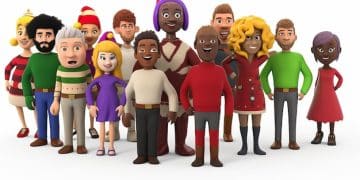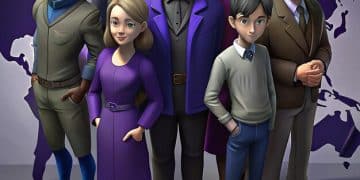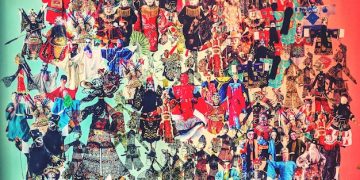Exploring the Best Animated Series: A Comprehensive Guide

Animated series have captivated audiences for generations, evolving from simple cartoons to complex narratives. This article delves into the best animated series, exploring their impact, artistic styles, and enduring appeal.
Animated series have evolved into a diverse and influential medium, capturing audiences of all ages with their unique storytelling and striking visuals. From groundbreaking classics to modern masterpieces, the world of animation offers something for everyone. Let’s explore some of the best animated series that have left a lasting impact on popular culture by using animated series.
The Golden Age of Animation
The golden age of animation laid the foundation for many of the animated series we enjoy today. Pioneers like Walt Disney and Hanna-Barbera introduced innovative techniques and memorable characters that continue to resonate with audiences worldwide.
Early Pioneers
Walt Disney’s contributions to animation are undeniable. His studio produced timeless classics such as “Snow White and the Seven Dwarfs” and “Fantasia,” which set a new standard for animated storytelling.
Hanna-Barbera, on the other hand, focused on television animation, creating popular series like “The Flintstones” and “Scooby-Doo.” These shows brought animation into the homes of millions and established the format for future animated series.
Key Characteristics
The golden age of animation was characterized by:
- Hand-drawn animation: Every frame was meticulously drawn and painted by hand, resulting in a distinctive artistic style.
- Simple storylines: Early animated series often featured straightforward, episodic narratives that were easy for audiences to follow.
- Memorable characters: Characters like Mickey Mouse and Fred Flintstone became household names, thanks to their endearing personalities and comedic antics.

The golden age of animation set the stage for future innovations and paved the way for the diverse range of animated series we enjoy today. These early pioneers demonstrated the power of animation as a storytelling medium and laid the groundwork for future generations of animators and creators.
Modern Animation: Pushing Boundaries
Modern animation has seen a surge in creativity and innovation, with animated series pushing the boundaries of storytelling and visual techniques. Shows like “Avatar: The Last Airbender” and “Rick and Morty” have redefined what animation can achieve, exploring complex themes and engaging audiences of all ages. Modern animated series now have even further reach.
Technological Advancements
The advent of computer animation has revolutionized the industry. Pixar’s “Toy Story” was the first fully computer-animated feature film, demonstrating the potential of this new technology.
Today, computer animation is used in a wide range of animated series, from “The Simpsons” to “Bojack Horseman.” This technology allows for more complex animation and greater control over the visual aspects of the show.
Complex Narratives
Modern animated series often feature complex narratives that explore mature themes and challenge traditional storytelling conventions. “Avatar: The Last Airbender,” for example, tells a sweeping epic story about war, peace, and redemption, while “Rick and Morty” delves into existential questions and the nature of reality.
- Character Development: Modern animated series often focus on character development, exploring the inner lives and motivations of their protagonists.
- Thematic Depth: Shows like “Bojack Horseman” tackle difficult issues, such as depression, addiction, and the search for meaning.
- Visual Experimentation: Modern animation is characterized by visual experimentation, with artists using innovative techniques to create unique and compelling worlds.
Modern animation has pushed the boundaries of what is possible, both technically and creatively. These shows demonstrate the power of animation as a medium for telling complex, engaging stories and exploring important themes.
Animated Series for Adults
Animated series are no longer just for kids. Shows like “The Simpsons,” “Family Guy,” and “South Park” have gained a large adult following with their irreverent humor, satirical commentary, and mature themes.
Satirical Comedy
“The Simpsons” is one of the longest-running animated series of all time. The show is known for its sharp satire of American culture and its memorable characters.
“South Park,” on the other hand, is known for its controversial humor and its willingness to tackle taboo subjects. The show’s creators, Trey Parker and Matt Stone, use animation to push boundaries and challenge social norms.
Dark Humor and Social Commentary
Animated series for adults often use dark humor and social commentary to engage with their audience. “Family Guy,” for example, is known for its cutaway gags and its over-the-top characters.
- Irreverent Humor: Adult animated series often feature irreverent humor that is not suitable for children.
- Satirical Commentary: Shows like “The Simpsons” use satire to comment on American culture and society.
- Mature Themes: Adult animated series often explore mature themes, such as sexuality, politics, and religion.
Animated series for adults have carved out a distinct niche in the television landscape. These shows demonstrate the versatility of animation as a medium for comedy, satire, and social commentary.
Animated Series for Children
Animation has always been a popular medium for children’s entertainment. Shows like “SpongeBob SquarePants,” “Dora the Explorer,” and “Paw Patrol” are beloved by kids around the world for their colorful characters, catchy songs, and positive messages.
Educational Content
Many animated series for children focus on educational content. “Dora the Explorer,” for example, teaches children basic Spanish and problem-solving skills.
“Sesame Street” is another long-running children’s show that uses animation to teach children about letters, numbers, and social skills.
Positive Role Models
Animated series for children often feature positive role models who embody important values, such as kindness, courage, and perseverance. “SpongeBob SquarePants,” for example, teaches children about the importance of friendship and optimism.
- Colorful Characters: Children’s animated series often feature colorful, engaging characters that appeal to young viewers.
- Catchy Songs: Many children’s shows include catchy songs that help children learn and remember important concepts.
- Positive Messages: Animated series for children often promote positive messages, such as kindness, empathy, and respect for others.
Animated series for children play an important role in shaping young minds and promoting positive values. These shows demonstrate the power of animation as a tool for education, entertainment, and social development.
Anime: A Global Phenomenon
Anime, or Japanese animation, has become a global phenomenon, with shows like “Dragon Ball Z,” “Sailor Moon,” and “Pokémon” gaining a large international following. Anime is known for its distinctive visual style, complex narratives, and diverse genres.
Distinctive Visual Style
Anime is characterized by its distinctive visual style, which includes large eyes, expressive characters, and dynamic action sequences.
The style of anime has evolved over time, but certain elements, such as the emphasis on visual storytelling and emotional expression, have remained constant.
Complex Narratives
Anime often features complex narratives that explore mature themes and challenge traditional storytelling conventions. “Spirited Away,” for example, tells a story about a young girl who must navigate a mysterious world of spirits and monsters.
- Diverse Genres: Anime encompasses a wide range of genres, from action and adventure to romance and comedy.
- Cultural Influences: Anime is deeply rooted in Japanese culture and history, and often reflects the values and traditions of Japanese society.
- Global Appeal: Anime has gained a large international following, thanks to its unique visual style, complex narratives, and diverse genres.
Anime has had a profound impact on global popular culture. Anime’s unique visual style, complex narratives, and diverse genres have captivated audiences around the world, leading to its widespread popularity and influence.
The Future of Animated Series
The future of animated series looks bright, with new technologies and innovative storytelling techniques constantly pushing the boundaries of what is possible. Virtual reality, augmented reality, and interactive animation are poised to revolutionize the way we experience animated series.
Virtual Reality
Virtual reality (VR) has the potential to transform the way we experience animated series. Imagine being able to step into the world of your favorite show and interact with the characters and environments.
VR animation is still in its early stages, but several projects have already demonstrated the potential of this technology. “Wolves in the Walls,” for example, is an interactive VR animation that allows viewers to become part of the story.
Interactive Animation
Interactive animation allows viewers to make choices that affect the outcome of the story. Netflix’s “Bandersnatch” is one example of interactive storytelling, but the concept could be applied to animated series as well.
- Augmented Reality: Augmented reality (AR) could be used to bring animated characters into the real world.
- Artificial Intelligence: Artificial intelligence (AI) could be used to create more realistic and engaging animated characters.
- New Platforms: New streaming platforms and distribution channels are emerging, creating new opportunities for animated series.
The future of animated series is full of possibilities. These new technologies and innovative storytelling techniques have the potential to revolutionize the way we experience animation and create new forms of entertainment. These kinds of animated series would revolutionize the industry!
| Key Point | Brief Description |
|---|---|
| 🎨 Golden Age | Hand-drawn animation, simple storylines, and memorable characters. |
| 🚀 Modern Era | Computer animation, complex narratives, and mature themes. |
| 👨👩👧👦 Adult Animation | Irreverent humor, satirical commentary, and mature themes. |
| 🌍 Anime | Distinctive visual style, complex narratives, and diverse genres. |
Frequently Asked Questions
▼
The golden age of animation typically refers to the period from the late 1930s to the 1960s, marked by significant advancements in animation techniques and the creation of iconic characters by studios like Disney and Hanna-Barbera.
▼
Computer animation has revolutionized the industry by allowing for more complex and detailed visuals, as well as greater control over the animation process, leading to more realistic and immersive animated series.
▼
Adult-oriented animated series gain popularity through their ability to tackle mature themes, offer satirical commentary on society, and employ irreverent humor, appealing to a demographic seeking more than just children’s entertainment.
▼
Animated series play a crucial role in education by presenting complex concepts in an engaging and easily digestible format, teaching valuable lessons and fostering positive values through memorable characters and storylines.
▼
Anime has significantly influenced global popular culture through its unique visual style, diverse genres, and complex narratives, captivating audiences worldwide and inspiring countless artists and storytellers.
Conclusion
Animated series continue to evolve, captivating audiences with their diverse storytelling and visual styles. They range from the early pioneers to the modern shows. These animated series have had a big impact in our world!





